Solar eclipse of August 11, 1999
| Solar eclipse of August 11, 1999 | |
|---|---|
 Totality from France | |
 Map | |
| Type of eclipse | |
| Nature | Total |
| Gamma | 0.5062 |
| Magnitude | 1.0286 |
| Maximum eclipse | |
| Duration | 143 sec (2 m 23 s) |
| Coordinates | 45°06′N 24°18′E / 45.1°N 24.3°E |
| Max. width of band | 112 km (70 mi) |
| Times (UTC) | |
| Greatest eclipse | 11:04:09 |
| References | |
| Saros | 145 (21 of 77) |
| Catalog # (SE5000) | 9506 |
A total solar eclipse occurred on 11 August 1999 with an eclipse magnitude of 1.0286. A solar eclipse occurs when the Moon passes between Earth and the Sun, thereby totally or partly obscuring the image of the Sun for a viewer on Earth. A total solar eclipse occurs when the Moon's apparent diameter is larger than the Sun's, blocking all direct sunlight, turning day into darkness. Totality occurs in a narrow path across Earth's surface, with the partial solar eclipse visible over a surrounding region thousands of kilometres wide. The path of the Moon's shadow began in the Atlantic Ocean and, before noon, was traversing the southern United Kingdom, northern France, Belgium, Luxembourg, southern Germany, Austria, Slovenia, Croatia, Hungary, and northern FR Yugoslavia (Vojvodina). The eclipse's maximum was at 11:03 UTC at 45°06′N 24°18′E / 45.1°N 24.3°E in Romania (next to a town called Ocnele Mari near Râmnicu Vâlcea); and it continued across Bulgaria, the Black Sea, Turkey, northeastern tip of Syria, northern Iraq, Iran, southern Pakistan and Srikakulam in India and ended in the Bay of Bengal.
It was the first total eclipse visible from Europe since 22 July 1990, and the first visible in the United Kingdom since 29 June 1927.
Observations[]
Because of the high population densities in areas of the path, this was one of the most-viewed total solar eclipses in human history;[1] although some areas in the path of totality (mainly in Western Europe) offered impaired visibility due to adverse weather conditions.
Some of the organized eclipse-watching parties along the path of totality set up video projectors on which people could watch the Moon's shadow as it raced towards them.[2] There was substantial coverage on International TV stations of the progress of the eclipse shadow. The Moon's shadow was also observed from the Russian Mir space station; during the eclipse, video from Mir was broadcast live on television.
- The BBC concentrated its coverage efforts on the first landfall of the shadow across the western end of Cornwall (from St Ives to Lizard), which was packed with an extraordinary number of visitors, although Cornwall did not have nearly as many as expected leading to many specially organised events being left with very small attendance. The veteran amateur astronomer, broadcaster and eclipse-watcher Patrick Moore was brought in to head a live programme, but the eclipse was clouded out. BBC One also produced a special version of their Balloon Idents for the event. The BBC did not have a presence at Goonhilly on the Lizard Peninsula, one of the few places in Cornwall where the clouds parted just in time for the total eclipse to be visible. There was extensive cloud in Perranporth which parted just in time, allowing the very large crowd that filled the beach and hillsides to witness the event.
- Some of the best viewing conditions were to be had mid-Channel, where ferries were halted in calm conditions to obtain an excellent view. Hundreds of people who gathered on the island of Alderney also experienced the event.
- A gathering of several thousand people at the airport in Soissons, France, which was on the path of totality, were denied all but a few fleeting glimpses of the eclipse through the overcast sky. The clouds cleared completely just a few minutes after the eclipse.
- In contrast, the overcast sky in Amiens, France, where thousands had gathered, cleared only minutes before the eclipse began.
- Further inland, viewing conditions were also perfect at Vouziers, a French country town gridlocked by Belgian cars from day-visitors. The patchy cloud covering cleared a short time before the shadow arrived. Some photos from Vouziers were used on the subsequent BBC Sky at Night programme.
- The San Francisco Exploratorium featured a live webcast from a crowded town square in Amasya, Turkey.
- Doordarshan, the national TV channel in India, broadcast live coverage from Srikakulam, hosted by the TV personality .
- A Bulgarian Air Force MiG-21 two-seater was used by the Bulgarian Academy of Sciences to study the solar corona. The MiG-21, flying at 1600–1700 km/h (M=1,4-1,5) at an altitude of 13,000 m, was able to stay in the Moon's umbra for 6 min. The photographer, an air force pilot, used two film cameras, both fitted with 200 mm lenses and infrared filters, and one Digital8 video camera.
- Hungary's most popular tourist destination, Lake Balaton and its surrounding area, fell into the path of the eclipse entirely, which made the area even more popular for that day. The motorway leading there was so crowded, many people had to watch the eclipse while caught in a traffic jam.
- One French and two British Concordes briefly followed the eclipse with tourists on board.[3]
- The BBC was filming one of its episodes for its TV series Airport that day and, during the show, resident press officers Russell Clisby and Steve Meller took photographs of the eclipse at Heathrow Airport, as well as Aeroflot supervisor Jeremy Spake witnessing the eclipse on a special charter flight.
- RTS, the national public broadcaster of Serbia, urged people to remain inside, citing dangers to public health. This caused the streets of all Serbian cities, towns and villages to be entirely deserted during the eclipse, with many opting to watch it on TV instead.[4]
- The BMJ a month after the eclipse reported only 14 cases of eye damage from improper viewing of the eclipse, a number lower than initially feared. In one of the most serious cases the patient had looked at the Sun without eye protection for twenty minutes, but overall the public health campaign had succeeded.[5]
Gallery[]

Salzburg, Austria

Partial from Paderborn, Germany

Partial from Oria, Italy

Partial from Haarlem, Netherlands

Projection in Oslo, Norway

Lake Balaton, Hungary
Notable times and coordinates[]


| Event | Time (UTC) | Coordinates[6] |
|---|---|---|
| 1st penumbral contact with Earth's surface (P1) | 08:26:17 | |
| 1st external umbral contact (U1) | 09:29:55 | 41°2.0′N 65°5.4′W / 41.0333°N 65.0900°W |
| 2nd internal umbral contact (U2) | 09:30:53 | 43°0.1′N 57°55.8′W / 43.0017°N 57.9300°W |
| Greatest eclipse | 11:03:07 | 45°4.8′N 24°17.3′E / 45.0800°N 24.2883°E[7] |
| 3rd internal umbral contact (U3) | 12:35:33 | 19°39.7′N 80°20.4′E / 19.6617°N 80.3400°E |
| 4th external umbral contact (U4) | 12:36:26 | 17°33.5′N 87°17.1′E / 17.5583°N 87.2850°E |
| 4th penumbral contact with Earth's surface (P4) | 13:40:08 |
Related eclipses[]
Eclipses of 1999[]
- A penumbral lunar eclipse on January 31.
- An annular solar eclipse on February 16.
- A partial lunar eclipse on July 28.
- A total solar eclipse on August 11.
Solar eclipses 1997–2000[]
This eclipse is a member of a semester series. An eclipse in a semester series of solar eclipses repeats approximately every 177 days and 4 hours (a semester) at alternating nodes of the Moon's orbit.[8]
| Solar eclipse series sets from 1997–2000 | ||||||
|---|---|---|---|---|---|---|
| Descending node | Ascending node | |||||
| Saros | Map | Gamma | Saros | Map | Gamma | |
120 Chita, Russia |
1997 March 09 Total |
0.91830 | 125 | 1997 September 02 Partial (south) |
-1.03521 | |
130 Total eclipse near Guadelope |
1998 February 26 Total |
0.23909 | 135 | 1998 August 22 Annular |
-0.26441 | |
| 140 | 1999 February 16 Annular |
-0.47260 | 145 Totality from France |
1999 August 11 Total |
0.50623 | |
| 150 | 2000 February 05 Partial (south) |
-1.22325 | 155 | 2000 July 31 Partial (north) |
1.21664 | |
| Partial solar eclipses on July 1, 2000 and December 25, 2000 occur in the next lunar year eclipse set. | ||||||
Saros 145[]
This solar eclipse is a part of Saros cycle 145, repeating every 18 years, 11 days, 8 hours, containing 77 events. The series started with a partial solar eclipse on January 4, 1639, and reached a first annular eclipse on June 6, 1891. It was a hybrid event on June 17, 1909, and total eclipses from June 29, 1927, through September 9, 2648. The series ends at member 77 as a partial eclipse on April 17, 3009. The longest eclipse will occur on June 25, 2522, with a maximum duration of totality of 7 minutes, 12 seconds. All eclipses in this series occurs at the Moon's ascending node.
| Series members 10–32 occur between 1801 and 2359 | ||
|---|---|---|
| 10 | 11 | 12 |
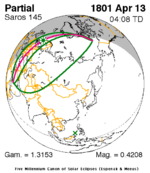 April 13, 1801 |
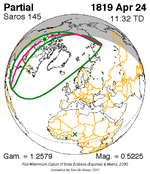 April 24, 1819 |
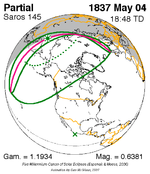 May 4, 1837 |
| 13 | 14 | 15 |
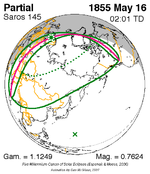 May 16, 1855 |
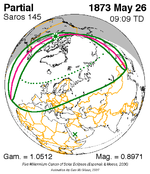 May 26, 1873 |
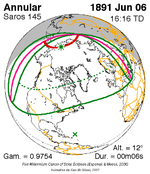 June 6, 1891 |
| 16 | 17 | 18 |
 June 17, 1909 |
 June 29, 1927 |
 July 9, 1945 |
| 19 | 20 | 21 |
 July 20, 1963 |
 July 31, 1981 |
 August 11, 1999 |
| 22 | 23 | 24 |
 August 21, 2017 |
 September 2, 2035 |
 September 12, 2053 |
| 25 | 26 | 27 |
 September 23, 2071 |
 October 4, 2089 |
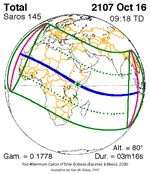 October 16, 2107 |
| 28 | 29 | 30 |
 October 26, 2125 |
 November 7, 2143 |
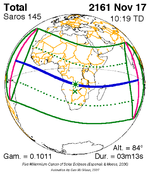 November 17, 2161 |
| 31 | 32 | 33 |
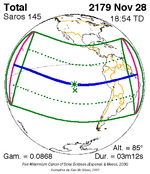 November 28, 2179 |
 December 9, 2197 |
 December 21, 2215 |
| 34 | 35 | 36 |
 December 31, 2233 |
 January 12, 2252 |
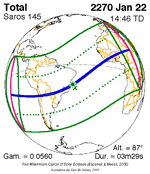 January 22, 2270 |
| 37 | 38 | 39 |
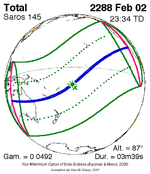 February 2, 2288 |
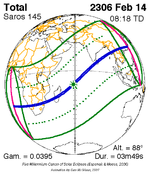 February 14, 2306 |
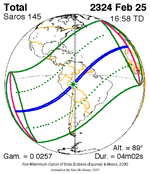 February 25, 2324 |
| 40 | ||
 March 8, 2342 | ||
Metonic series[]
The metonic series repeats eclipses every 19 years (6939.69 days), lasting about 5 cycles. Eclipses occur in nearly the same calendar date. In addition, the octon subseries repeats 1/5 of that or every 3.8 years (1387.94 days). All eclipses in this table occur at the Moon's ascending node.
| 22 eclipse events between January 5, 1935 and August 11, 2018 | ||||
|---|---|---|---|---|
| January 4-5 | October 23-24 | August 10-12 | May 30-31 | March 18-19 |
| 111 | 113 | 115 | 117 | 119 |
 January 5, 1935 |
 August 12, 1942 |
 May 30, 1946 |
 March 18, 1950 | |
| 121 | 123 | 125 | 127 | 129 |
 January 5, 1954 |
 October 23, 1957 |
 August 11, 1961 |
 May 30, 1965 |
 March 18, 1969 |
| 131 | 133 | 135 | 137 | 139 |
 January 4, 1973 |
 October 23, 1976 |
 August 10, 1980 |
 May 30, 1984 |
 March 18, 1988 |
| 141 | 143 | 145 | 147 | 149 |
 January 4, 1992 |
 October 24, 1995 |
 August 11, 1999 |
 May 31, 2003 |
 March 19, 2007 |
| 151 | 153 | 155 | ||
 January 4, 2011 |
 October 23, 2014 |
 August 11, 2018 |
||
See also[]
- List of solar eclipses visible from the United Kingdom
Notes[]
- ^ "Solar show in sky or on the Internet".
- ^ "ISMB 99". Bioinf.mpi-sb.mpg.de. Retrieved 2013-10-01.
- ^ Hatherill, Chris (9 March 2016). "When Astronomers Chased a Total Eclipse in a Concorde". Vice. Retrieved 10 March 2016.
- ^ "Atmosfear: Slobodan Milošević versus 1999 Solar Eclipse". Centre for the History of Science, Technology of Medicine. July 2010.
- ^ Dobson, Roger (1999-08-21). "UK hospitals assess eye damage after solar eclipse". The BMJ. 319: 469. doi:10.1136/bmj.319.7208.469. PMC 1116382. PMID 10454393.
- ^ "Eclipse2017 - Total Solar Eclipse 2017". eclipse.gsfc.nasa.gov.
- ^ "Eclipse2017 - Total Solar Eclipse 2017". eclipse.gsfc.nasa.gov.
- ^ van Gent, R.H. "Solar- and Lunar-Eclipse Predictions from Antiquity to the Present". A Catalogue of Eclipse Cycles. Utrecht University. Retrieved 6 October 2018.
References[]
- Earth visibility chart and eclipse statistics Eclipse Predictions by Fred Espenak, NASA/GSFC
| Wikimedia Commons has media related to Solar eclipse of 1999 August 11. |
- Eclipse at hermit.org
- "Club Krile Magazine", Vol. 11, 1999, "Air Group 2000" Publishing, Sofia, Bulgaria
- The Total Solar Eclipse of 1999 August 11
- Russia expedition
- Photos
- Turkey. Prof. Druckmüller's eclipse photography site
- Hungary. Prof. Druckmüller's eclipse photography site
- France. Prof. Druckmüller's eclipse photography site
- Bulgaria
- Solar Corona Shape
- Exploratorium Webcast: Solar Eclipse August 11, 1999
- KryssTal - Eclipse in Cornwall (UK)—totality not seen but scene photographed
- Solar eclipse of August 11, 1999 Romania, shown in Romanian Maximum Card
- Solar eclipse of August 11, 1999 Romania, shown in Romanian Maximum Card
- Images from Turkey by Crayford Manor House Astronomical Society
- A Crescent Sunrise, APOD 8/17/1999, partial eclipse from Quebec, Canada
- Sun Block, APOD 8/18/1999, totality from Hungary
- Light From The Dark Sun, APOD 8/19/1999, totality from Siofok, Hungary
- At The Sun's Edge, APOD 8/20/1999, totality near Bagdere, Turkey
- The Big Corona, APOD 4/8/2001, totality by Fred Espenak
- Total Eclipse of the Active Sun, APOD 6/20/2001, from Kecel, Hungary
- Diamond Ring in the Sun, APOD 6/21/2001, totality from eastern Turkey
- Looking Back at an Eclipsed Earth, APOD 9/26/2004, total eclipse shadow seen from Mir spacestation, chosen as APOD again on 6/10/2007
- Russian scientist observed eclipse
- Total solar eclipses
- 20th-century solar eclipses
- 1999 in science
- August 1999 events in Asia
- 1999 in the United Kingdom
- 1999 in France
- 1999 in Belgium
- 1999 in Luxembourg
- 1999 in Germany
- 1999 in Austria
- 1999 in Slovakia
- 1999 in Slovenia
- 1999 in Hungary
- 1999 in Romania
- 1999 in Yugoslavia
- 1999 in Bulgaria
- 1999 in Turkey
- 1999 in Iran
- 1999 in Iraq
- 1999 in Syria
- 1999 in Pakistan
- 1999 in India
- August 1999 events in Europe









